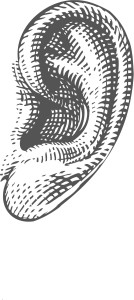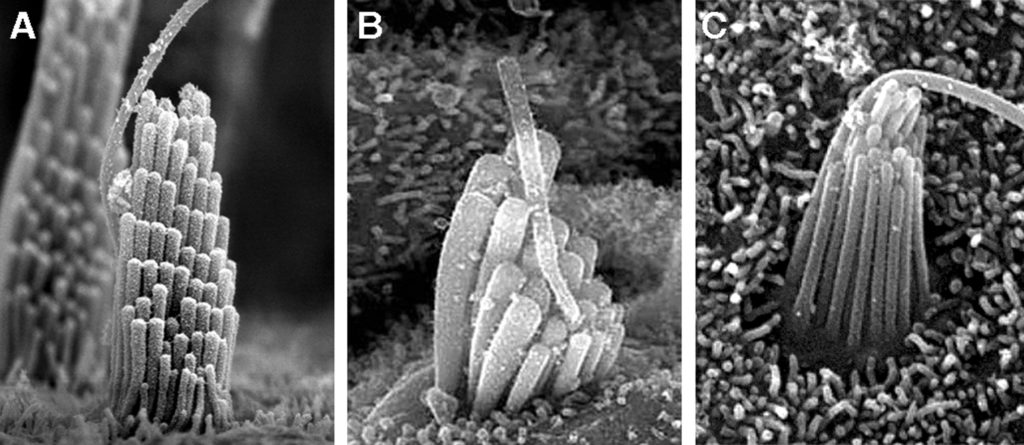 This post is adapted from a commentary in this week’s edition of Science by Jeffrey R. Holt, PhD, and Gwenaelle S. G. Géléoc, PhD, of the Department of Otolaryngology and F.M. Kirby Neurobiology Center at Boston Children’s Hospital.
This post is adapted from a commentary in this week’s edition of Science by Jeffrey R. Holt, PhD, and Gwenaelle S. G. Géléoc, PhD, of the Department of Otolaryngology and F.M. Kirby Neurobiology Center at Boston Children’s Hospital.
Hearing loss affects more than 300 million people worldwide, making it the most common sensory disorder. While there are no cures, recent efforts to develop biological treatments for hearing loss provide reason for cautious optimism. Three strategies—gene therapy, stem cells and drugs—have shown encouraging results in animal models, poising them for translation into potential therapies for humans.
Hearing loss can arise from many different causes, so it is unlikely that a single “magic bullet” will be developed to treat all forms of deafness. Rather, each individual cause may require a tailored and specific treatment strategy.
Neurosensory hearing loss, which affects the sensory cells and neurons in the inner ear, can be caused by hereditary and acquired factors and in some cases, both. Hereditary or genetic hearing loss affects 1 in 1,000 babies at birth and becomes more prevalent throughout life as a result of progressive conditions or genetic predispositions to age-related hearing loss. Acquired hearing loss can result from environmental factors such as overexposure to loud sounds, aminoglycoside antibiotics, cancer chemotherapeutics (such as cisplatin) and bacterial or viral infections.
Developing cures for this vast array of causes has been challenging, but there has been exciting recent progress with biological therapies for some forms of hearing loss.
- Gene therapy—using an engineered virus to deliver a healthy gene—is on the horizon for treating some forms of genetic and acquired hearing loss. Viral vectors have successfully transferred normal gene sequences into the sensory cells of deaf mice, restoring several aspects of normal auditory function and raising hopes that similar strategies could be adapted for use in deaf humans.

Inner ear sensory cells. (A) A native hair cell of the mouse inner ear (from Holt et al., Cell 2002). (B) A hair cell created by Atoh1 gene therapy (from Kawamoto et al., J Neurosci 2003). (C) A stem-cell-derived hair cell (from Oshima et al., Cell 2010). Images used with permission.
In another promising line of gene therapy research, scientists have identified a gene sequence, Atoh1, that is necessary for development of inner ear sensory (hair) cells. The Atoh1 sequence has been packaged into viral vectors, introduced into the ears of deaf animals and taken up by non-sensory cells, instructing them to become sensory cells and restoring some auditory responses. This strategy was recently approved for clinical trials in humans, and the outcome will surely be followed with great anticipation.
Yet another recently reported approach used injected DNA encoding a growth factor called BDNF combined with cochlear implants, whose electrical pulses helped drive the DNA into cells. This approach temporarily restored sound sensitivity in deaf guinea pigs.
- Stem cell therapies are also being developed to generate new sensory cells and the inner ear neurons that relay sound information to the brain. The ability to generate multiple cell types from stem cells has captured the hopes and attention of scientists, clinicians and patients, but a number of hurdles still need to be overcome before stem cell therapy can be a viable clinical option for hearing loss. In particular, it is not clear how these stem-cell-derived cells will be integrated into the existing complex structure of the inner ear and whether they will form the proper connections with other cells.
- Pharmacologic approaches. Perhaps most promising is the potential to use novel drugs to promote the generation of new sensory cells from neighboring supporting cells. By manipulating native signaling pathways in animal models, scientists have recently shown that inner ear supporting cells have the capacity to become sensory cells. Several biotech companies are now working to move this approach into viable therapies for treating human deafness. The challenge will be to identify compounds or methods that target inner ear cells specifically, without causing side effects or disrupting signaling pathways elsewhere.
We envision a sound future in which hearing loss patients diagnosed with a specific genetic deafness will receive a tailored gene therapy that targets the causative mutation. Patients who receive a diagnosis of hair cell or neuron damage could be prescribed a treatment regime that includes stems cells or pharmacologic agents to stimulate production of new inner ear cells and restore auditory function. Millions of hearing loss patients worldwide could benefit, but success will require additional financial support from government agencies, foundations, private individuals and industry partnerships.
To learn more about supporting work in the Holt/Géléoc lab, contact [email protected].






